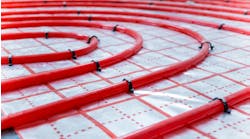Latest from Plumbing
Sponsored
BY ROBERT P. MADER of CONTRACTOR’s staff
COMMACK, N.Y. — In 2005, U.S. manufacturers’ sales of plumbing fixtures and fittings are expected to reach $8.7 billion. Research firm Business Trend Analysts here projects that sales of plumbing fixtures and fittings will rise to $11.2 billion in 2013, reflecting average annual growth of 3.4% from their 2003 level.
Business Trends Analysts released its findings in March in its report “The 2005/2006 Outlook for the U.S. Plumbing Fixtures and Fittings Industry.” The report includes projections out to 2013.
Slightly more than half of U.S. manufacturers’ sales are derived from plumbing fittings (54% in 2004), with the remainder coming from plumbing fixtures, according to the report. U.S. manufacturers of fixtures and fittings posted fairly steady sales growth from 1998 to 2004, with an average annual rate of 2.2%.
Considering fixtures only, manufacturers’ sales of plumbing fixtures have been able to maintain steady growth because of the continuing growth of new construction and remodeling and replacement projects. From 1998 to 2004, sales of plumbing fixtures grew at an average annual rate of 4%. Notably, that time frame included a period during which the country was in a recession.
From 2003 to 2013, the firm projects that U.S. manufacturers’ sales of plumbing fixtures will grow at an average annual rate of 3.2% to reach $4.99 billion by 2013.
Bathtubs remain the single biggest category, with annual sales of more than $817 million. Despite a decline in sales in 2002, U.S. manufacturers’ sales of bathtubs grew by an average of 2.1% per year from 1999 to 2004. BTA noted the burgeoning popularity of bubble-type tubs.
BTA estimates that in 2005, sales of bathtubs will increase by 3.9% to total $817.9 million. The number of units sold is expected to rise by 2.2% to 4.5 million.
The wide variety of kitchen sink styles, configurations and colors has kept sales strong, BTA reported. In 2004, U.S. manufacturers’ sales of kitchen sinks rose by 6.2% to total $482.5 million. This marked a decent jump from the $454.3 million in sales posted in 2003. The majority of kitchen sinks sold in the U.S. market are made of stainless steel. In terms of average manufacturers’ prices, cast-iron kitchen sinks cost the most, followed by stainless steel and then enameled steel sinks.
For fittings and brass goods, the market grew at an average annual rate of 3.4% from 1994 to 2004. Following a 1.8% increase in 2004, U.S. manufacturers’ sales of plumbing fittings and brass goods will increase by an estimated 5.2% to total $4.7 billion in 2005, BTA predicts.
From 2002 to 2006, manufacturers’ sales of single-lever controls are expected to rise at an average annual rate of 3.1%. Manufacturers’ sales in this segment should reach $712.1 million in 2006. Nearly 41.9%, or $298.5 million, of that total will come from mechanical shower/tub controls. Another large percentage of sales comes from kitchen faucets with sprays, a category that should reach $163.1 million in sales in 2006.
Paradoxically, while manufacturers’ sales have been growing at a steady rate, the share of sales accounted for by single-lever controls has continued to drop. The market share is expected to fall to an estimated 14.9% in 2006, down from 16.1% in 1997.
With more and more legislation being passed regarding anti-scald valves, these fittings are becoming the norm for homes and buildings. As a result, from 2002 to 2006, sales should increase at an average annual rate of 5.5% to reach $434.9 million.
BTA projects that U.S. manufacturers’ sales of plumbing fittings and brass goods will grow at an average annual rate of 3.6% from 2003 to 2013. This will bring the market to $6.24 billion at the end of that period. The strongest sales growth in this market is expected to be in the sink fittings segment.
BTA project director for the report is Robert Imbriani. The 600-plus-page report is available from BTA for $1,995 by calling 800/866-4648 or 631/462-5454, or online at [email protected].

